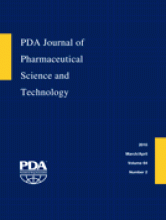Abstract
The purpose of this study was to qualify the MicroWorks, Inc. Swab Sampling System (MSSS™) swab kit for use in sampling cleanroom surfaces for bioburden. A six-part study was performed to demonstrate the suitability of the swab materials, the recovery of bioburden from typical cleanroom surfaces, the neutralization of typical disinfectants used in cleanrooms, the removal of diluents from the swabbed surface, and the hold time for test samples. A total of 13 challenge organisms were used: six National Collection of Type Cultures/American Type Culture Collection (NCTC/ATCC) standard culture organisms and seven environmental isolates, which were recovered from different MedImmune manufacturing facilities.
Based on the results of the study it was shown that 12 of the challenge organisms were recovered from the calcium alginate swab materials and 13 of the challenge organisms were recovered from the sodium citrate diluent at ≥70%. Eleven organisms, including the six NCTC/ATCC organisms and five of the environmental organisms, were recovered from stainless steel, glass, polyvinylchloride curtain material, latex glove material, and neoprene at a rate of ≥70%. Effective neutralization was shown for LpH (an acid phenolic compound manufactured by Steris Corporation, Mentor, OH), Vesphene II, Spor-Klenz, 70% isopropyl alcohol (IPA), and Biocides B, X, and Y when utilizing the filtration/rinsing process. Recovery of six NCTC/ATCC organisms was demonstrated at ≥70%. The study also demonstrated that the diluents could easily be removed from the swabbed surface by following the swab with a 70% IPA wipe. A hold time of at least 24 h was demonstrated when samples were stored at 2–8 °C.
The results of this study demonstrated that the MSSS™ swab kit and qualified test method recover ≥70% of surface bioburden from common cleanroom surfaces in the presence of a wide variety of disinfectants.
- Swab
- Swab sampling
- Microbial surface recovery
- Bioburden recovery
- Surface sampling
- Environmental monitoring
- Disinfectant neutralization
- © PDA, Inc. 2010
PDA members receive access to all articles published in the current year and previous volume year. Institutional subscribers received access to all content. Log in below to receive access to this article if you are either of these.
If you are neither or you are a PDA member trying to access an article outside of your membership license, then you must purchase access to this article (below). If you do not have a username or password for JPST, you will be required to create an account prior to purchasing.
Full issue PDFs are for PDA members only.
Note to pda.org users
The PDA and PDA bookstore websites (www.pda.org and www.pda.org/bookstore) are separate websites from the PDA JPST website. When you first join PDA, your initial UserID and Password are sent to HighWirePress to create your PDA JPST account. Subsequent UserrID and Password changes required at the PDA websites will not pass on to PDA JPST and vice versa. If you forget your PDA JPST UserID and/or Password, you can request help to retrieve UserID and reset Password below.






